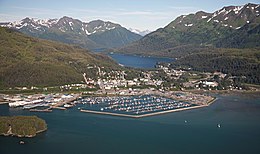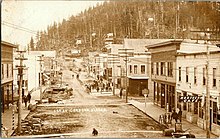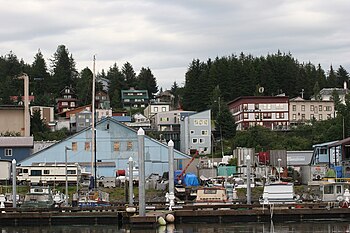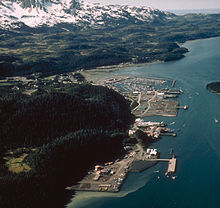Cordova, Alaska
Cordova | |
|---|---|
 Aerial view of central Cordova, Eyak Lake and the portion of theChugach Mountainssurrounding the city. | |
| Nickname: The Crossroads of Alaska | |
 Location of Cordova, Alaska | |
| Coordinates:60°32′37″N145°45′07″W/ 60.54361°N 145.75194°W | |
| Country | United States |
| State | Alaska |
| Census Area | Chugach |
| Incorporated | July 8, 1909[1] |
| Government | |
| •Mayor | David Allison[2][3] |
| •State senator | Gary Stevens(R) |
| •State rep. | Louise Stutes(R) |
| Area | |
| • Total | 75.14 sq mi (194.62 km2) |
| • Land | 61.35 sq mi (158.89 km2) |
| • Water | 13.80 sq mi (35.73 km2) |
| Elevation | 82 ft (25 m) |
| Population (2020) | |
| • Total | 2,609 |
| • Density | 42.53/sq mi (16.42/km2) |
| Time zone | UTC-9(Alaska (AKST)) |
| • Summer (DST) | UTC-8(AKDT) |
| ZIP code | 99574 |
| Area code | 907 |
| FIPS code | 02-17410 |
| GNISfeature ID | 1421215 |
| Website | CityofCordova.net |
Cordova(/kɔːrˈdoʊvə,ˈkɔːrdəvə/kor-DOH-və,KOR-də-və) is a city inChugach Census Area,[a]Alaska,United States.It lies near the mouth of theCopper River,at the head ofOrca Inleton the east side ofPrince William Sound.The population was 2,609 at the2020 census,up from 2,239 in 2010.[6]
Cordova was namedPuerto Córdobaby Spanish explorerSalvador Fidalgoin 1790. No roads connect Cordova to other Alaskan communities, so a plane or ferry is required to travel there. In theExxon Valdez oil spillof March 1989, an oil tanker ran aground northwest of Cordova, heavily damaging ecology and fishing. It was cleaned up shortly after, but there are lingering effects, such as a lowered population of some birds.
History[edit]

In 1790, theinletin front of the current Cordova townsite was named Puerto Cordova by Spanish explorerSalvador Fidalgo.The city of Cordova was named after it, although the inlet itself was later renamed theOrca Inlet.[7]Cordova proper was founded as a result of the discovery of high-grade copper ore atKennecott,north of Cordova. A group of surveyors fromValdezlaid out a town site andMichael James Heneypurchased half the land for the terminus of theCopper River and Northwestern Railwayafter determining that the neighboring town ofKatallawas a poor harbor.[8]Heney and his crew held a brief ceremony to organize the town on March 26, 1906. A week later, crews arrived to begin work on the railroad. The first lots in the new town site, making up the heart of present-day Cordova, were sold at auction in May 1908. As the railroad grew, so did the town. Eventually schools, businesses, a hospital, and utilities were established. After the railroad was completed, Cordova became the transportation hub for the ore coming out of Kennecott. From 1911 to 1938, more than 200 million tons of copper ore were transported through Cordova.[8]

The area around Cordova was historically home to theEyak,with a population ofChugachto the west, and occasional visits fromAhtnaandTlingit peoplefor trade or battle.[9]The last fluent Eyak speakerMarie Smith Jonesdied in 2008, but the native people, as well as their traditions and lifestyle, continue to thrive in the region. Cordova was also once the home of a boomingrazor clamindustry. Between 1916 and the late 1950s, it was known as the "Razor Clam Capital of the World".[10]Commercial harvest in the area reached as high as 3.5 million pounds. Returns began declining in the late 1950s, presumably due tooverharvestingand a large die-off in 1958. The 1964Good Friday earthquakeeffectively obliterated the industry; in some areas, the ground was thrust up by as much as six feet, exposing the already depleted clam beds. There has been no commercial harvest in the area since 1988 with the exception of a brief harvest in 1993.[11]

In March 1989 theExxon Valdezoil tankerran aground onBligh Reefnorth of Cordova causing one of the most devastatingenvironmental disastersin North America. TheExxon Valdez oil spillseverely affected the area'ssalmonandherringpopulations leading to a recession of the local fishing-reliant economy as well as a disruption to the area's ecology.[12]After many years of litigation, 450 million dollars were awarded forcompensatoryandpunitive damages.
Demographics[edit]
| Census | Pop. | Note | %± |
|---|---|---|---|
| 1910 | 1,152 | — | |
| 1920 | 955 | −17.1% | |
| 1930 | 980 | 2.6% | |
| 1940 | 938 | −4.3% | |
| 1950 | 1,165 | 24.2% | |
| 1960 | 1,128 | −3.2% | |
| 1970 | 1,164 | 3.2% | |
| 1980 | 1,879 | 61.4% | |
| 1990 | 2,110 | 12.3% | |
| 2000 | 2,454 | 16.3% | |
| 2010 | 2,239 | −8.8% | |
| 2020 | 2,609 | 16.5% | |
| U.S. Decennial Census[13] | |||
Cordova first appeared on the 1910 U.S. Census as an incorporated city. It incorporated the year before in 1909.
As of the2010 United States Census,there were 2,239 people living in the city. The racial makeup of the city was 68.3% White, 0.4% Black, 8.7% Native American, 10.7% Asian, <0.1% Pacific Islander and 7.6% from two or more races. 4.2% were Hispanic or Latino of any race.
As of the census of 2000,[14]there were 2,454 people, 958 households, and 597 families living in the city. The population density was 40.0 per square mile (15.4/km2). There were 1,099 housing units at an average density of 17.9 per square mile (6.9/km2). The racial makeup of the city was 71.1%White,23.6%Alaska Nativeandother Native American,10.1%Asian,0.4%Black or African American,1.3% fromother races,and 6.7% fromtwo or more races.Hispanics or Latinosof any race were 3.1% of the population.
There were 958 households, out of which 36.1% had children under the age of 18 living with them, 49.5% were married couples living together, 8.1% had a female householder with no husband present, and 37.6% were non-families. 30.3% of all households were made up of individuals, and 5.4% had someone living alone who was 65 years of age or older. The average household size was 2.48 and the average family size was 3.17.
The age distribution was 28.0% under the age of 18, 7.1% from 18 to 24, 32.8% from 25 to 44, 25.4% from 45 to 64, and 6.8% who were 65 years of age or older. The median age was 37 years. For every 100 females, there were 119.5 males. For every 100 females age 18 and over, there were 120.4 males.
The median income for a household in the city was $50,114, and the median income for a family was $65,625. Males had a median income of $40,444 versus $26,985 for females. The per capita income for the city was $25,256. About 4.3% of families and 7.5% of the population were below the poverty line, including 8.2% of those under the age of 18 and 6.2% of those 65 and older.
Geography[edit]
Cordova is located within theChugach National Forestat60°32′34.1″N145°45′36.59″W/ 60.542806°N 145.7601639°W(60.542805, −145.760164).[15] According to theUnited States Census Bureau,the city has a total area of 75.6 square miles (196 km2), of which, 61.4 square miles (159 km2) of it is land and 14.3 square miles (37 km2) of it is water. The total area is 18.87% water.
Climate[edit]
Cordova has a maritime-influencedsubarctic climate(KöppenDfc) bordering on both ahumid continental climate(Dfb) and asubpolar oceanic climate(Cfc), characterised by cool to mild, rainy summers and moderately cold, snowy winters. Precipitation is very heavy year round. The cool temperatures and heavy rainfall are caused byorographic lift.Westerly winds coming off the North Pacific Ocean are forced upwards by theChugach Mountainswhich causes the air mass to cool and creates clouds and precipitation.
Yearly average precipitation is 148.37 inches (3,769 mm),[16]with 125 rainy days out of the year. Snow falls mostly from December to March, and an average of 127 inches or 3.2 metres falls yearly. Winter temperatures reach lows of 15 °F or −9.4 °C and the warmest summer temperatures are around 77 °F or 25 °C.[17]
Most official climate data is recorded at the airport, which is 11 miles from the settlement. Temperatures and precipitation vary drastically between the city and the airport, and precipitation at the city is commonly twice that of the airport.
| Climate data for Cordova, Alaska (1991–2020 normals, extremes 1909–present) | |||||||||||||
|---|---|---|---|---|---|---|---|---|---|---|---|---|---|
| Month | Jan | Feb | Mar | Apr | May | Jun | Jul | Aug | Sep | Oct | Nov | Dec | Year |
| Record high °F (°C) | 59 (15) |
58 (14) |
68 (20) |
74 (23) |
82 (28) |
90 (32) |
89 (32) |
86 (30) |
78 (26) |
72 (22) |
60 (16) |
66 (19) |
90 (32) |
| Mean maximum °F (°C) | 47.0 (8.3) |
46.6 (8.1) |
49.5 (9.7) |
58.9 (14.9) |
70.1 (21.2) |
74.8 (23.8) |
74.5 (23.6) |
73.8 (23.2) |
66.5 (19.2) |
56.7 (13.7) |
49.3 (9.6) |
46.0 (7.8) |
78.9 (26.1) |
| Mean daily maximum °F (°C) | 33.7 (0.9) |
36.7 (2.6) |
39.1 (3.9) |
46.5 (8.1) |
54.1 (12.3) |
59.4 (15.2) |
61.6 (16.4) |
61.9 (16.6) |
56.4 (13.6) |
47.5 (8.6) |
38.4 (3.6) |
35.3 (1.8) |
47.5 (8.6) |
| Daily mean °F (°C) | 26.4 (−3.1) |
29.1 (−1.6) |
30.8 (−0.7) |
38.1 (3.4) |
45.5 (7.5) |
51.4 (10.8) |
54.6 (12.6) |
54.1 (12.3) |
48.4 (9.1) |
40.1 (4.5) |
31.6 (−0.2) |
28.9 (−1.7) |
39.9 (4.4) |
| Mean daily minimum °F (°C) | 19.0 (−7.2) |
21.4 (−5.9) |
22.5 (−5.3) |
29.8 (−1.2) |
36.8 (2.7) |
43.5 (6.4) |
47.6 (8.7) |
46.4 (8.0) |
40.3 (4.6) |
32.7 (0.4) |
24.8 (−4.0) |
22.4 (−5.3) |
32.3 (0.2) |
| Mean minimum °F (°C) | −2.2 (−19.0) |
2.1 (−16.6) |
5.3 (−14.8) |
18.1 (−7.7) |
27.3 (−2.6) |
34.0 (1.1) |
38.6 (3.7) |
36.0 (2.2) |
28.3 (−2.1) |
19.4 (−7.0) |
7.9 (−13.4) |
3.2 (−16.0) |
−7.1 (−21.7) |
| Record low °F (°C) | −30 (−34) |
−33 (−36) |
−24 (−31) |
−9 (−23) |
19 (−7) |
23 (−5) |
33 (1) |
23 (−5) |
20 (−7) |
−1 (−18) |
−17 (−27) |
−23 (−31) |
−33 (−36) |
| Averageprecipitationinches (mm) | 6.22 (158) |
5.95 (151) |
4.69 (119) |
4.48 (114) |
5.41 (137) |
4.58 (116) |
5.70 (145) |
9.93 (252) |
13.21 (336) |
10.88 (276) |
7.16 (182) |
7.97 (202) |
86.18 (2,188) |
| Average snowfall inches (cm) | 20.6 (52) |
18.7 (47) |
20.0 (51) |
4.9 (12) |
0.8 (2.0) |
0.0 (0.0) |
0.0 (0.0) |
0.0 (0.0) |
0.0 (0.0) |
1.1 (2.8) |
9.9 (25) |
24.5 (62) |
100.5 (253.8) |
| Average precipitation days(≥ 0.01 in) | 17.3 | 15.6 | 15.4 | 16.5 | 17.2 | 17.2 | 19.2 | 19.7 | 21.1 | 20.8 | 17.9 | 19.7 | 217.6 |
| Average snowy days(≥ 0.1 in) | 8.1 | 7.1 | 7.9 | 3.0 | 0.1 | 0.0 | 0.0 | 0.0 | 0.0 | 1.0 | 5.6 | 8.7 | 41.5 |
| Source 1: NWS[18] | |||||||||||||
| Source 2: NOAA (average snowfall/snow days 1981–2010)[19][20] | |||||||||||||
Economy[edit]

Commercial fishingis the main industry in Cordova. Half of all households in Cordova have at least one person involved in commercial fishing or processing. The fishing fleet mainly fishes the Prince William Sound and Copper River Delta area. There are various fisheries in the area, the most economically important of which is thesalmonfishery.

All Pacific salmon species except for thecherry salmonare caught. Fishermen use either apurse seine,driftgillnet,or set gillnet to catch the fish. All fisheries are regulated by theAlaska Department of Fish and Game.The fisheries in Alaska have alimited entry permit system.The first fish processing plant near Cordova opened in 1887.[21]In 2009 there were 159 purse seine, 511 drift gillnet, and 27 set gillnet permits fished in the Prince William Sound and Copper River Delta area.[22]
Arts and culture[edit]
Various festivals and celebrations take place throughout the year. The Copper River Delta Shorebird Festival, hosted by the Cordova Chamber of Commerce, takes place each year in early May. Millions ofmigratingshorebirds stop in the area to rest and feed before finishing their journey north. The most numerous species are thewestern sandpiper,least sandpiper,anddunlin.This is a popular time for avid and casual bird watchers to visit. Activities, workshops, and bird watching tours are held throughout the week.[23]
The CordovaIcewormFestival takes place each February. Activities include a parade, talent show, royal crowning ceremony, and various competitions such as anoyster shuckingcontest,ping pongtournament, and asurvival suitrace.[24]
Copper River Wild Salmon Festival takes place in July at theMt. Eyakski area and includes various events.[25]Salmon Jam Music Festival serves as one of the main events and a fund raiser for Cordova Arts, where local musicians perform followed by professional acts and takes place over the course of Friday and Saturday nights. Taste of Cordova, a wild food and Copper River salmon cook off, usually starts the events. Entries are made with a variety of wild, locally harvested foods and are judged by a panel of guest chefs and food writers. The Alaska Salmon Runs start Saturday morning and include amarathon,half marathon, 10k, 5k, and a 1-mile race on theCopper River Highway.[26]SmallFryactivities are educational events for children and families that take place during the races.
The Cordova Historical Museum has exhibits on the Copper River and Northwestern Railway, the local fishing industry, andAlaska Natives.They also host a juried art show called "Fish Follies".[27]
The Ilanka Cultural Center museum features exhibits on Eyak, Alutiiq, Ahtna and Tlingit history and contemporary life – including artifacts, photographs, and oral histories. The 24-1/2-foot orca whale, Eyak, is one of only five fully rearticulated orca whale skeletons in the world.
The Cordova Ikumat Alutiiq group was formed in 1995, composed of youth and adults, and is open to anyone who wants to join; the group performs songs from the past as well as original pieces. The Ilanka Cultural Center offers traditional arts and skills still practiced including skin sewing, beadwork; mask, totem, and ivory carving; "putting up" fish and deer; berry-picking and jam-making; and subsistence and commercial fishing.[28]
Cordova Center[edit]
In late 2010, clearing the site and construction of a 33,929-square-foot (3,152.1 m2) community center, to be named the Cordova Center, began. The Cordova Center hosts a new library, museum, auditorium, conference and meeting space, plus city hall offices. It finally opened in the winter of 2015 for the residents of Cordova. Various events take place in the walls of this building such as community movie nights in the theater, winter bazaars, art shows, and many more.[29]
Sports and recreation[edit]

Skiingis a popular activity in the winter. The surroundingChugach Mountainsprovide excellent back country ski slopes. TheMt. Eyakski area operates a single chair ski lift and rope tow. It is the oldest working ski lift in North America.[30]Snowshoeing and ice skating are very popular sports around the Cordova area when conditions are right.[31]
Hikingis available year-round on many trails. Some are within walking distance of the city while many others are a leisurely drive away. "Easy Trails" include:[32]
- Eyak River atCopper River Highwaymile 5.7
- Alaganik Slough Trail via Copper River Highway to mile 16.9; turn south on Alaganik Slough Road then follow the main road for 2.9 miles. The trail begins on the east side of the road.
- Pipeline Lakes Trail at Copper River Highway mile 21.4
- McKinley Lake Trail at Copper River Highway mile 21.6
- Saddlebag Glacier Trail via Copper River Highway to mile 24.6; turn north on firewood cutting road; trail begins one mile away at the end of the road.
In the summerkayakinginPrince William Soundis popular.[citation needed]The Sound has more tidewaterglaciersthan any other region in North America.[33]1,900,000 acres (7,700 km2) of the western Sound are designated as the Nellie Juan College FjordWilderness Study Area.[34]
Indoor recreation includes the Bob Korn Memorial Pool, and the Bidarki Fitness Center, which has a gym with basketball court upstairs, a weight room, and multiple spaces with cardio training equipment[35]
The Meals Reservoir Disc Golf Course is a public disc golf course erected in the summer of 2018, located near Meals Reservoir off Whitshed Rd.[36]
Government[edit]
The City of Cordova has aCouncil-Managertype government. TheCity Councilis thelegislative bodyand has 7 seats. The council is presided over by the Mayor. The Mayor is the ceremonial head of city government and has the power to veto anyordinance.[37]The city council appoints theCity Managerfor an indefinite term (he may be removed at any time by the council). The City Manager is head of the administrative branch of the city government. He executes all ordinances and laws and administers the government of the city.[38]
The city levies a property tax as well as a 6 percent sales tax.[39]
Education[edit]
TheCordova School Districtoperates the schools in the community. Mt. Eccles elementary school is the only public primary education facility in Cordova and had an enrollment of 206 students in 2008. Public secondary education is served by a single combinedjunior and senior high school.The high school had an enrollment of 205 students in 2008. The Cordova School District has 26 employed teachers.[40]Post secondary education is provided by thePrince William Sound College,a community campus ofUniversity of Alaska Anchorage.
Media[edit]
The independently owned city newspaper, theCordova Times,established in 1914 is published weekly and distributed every Friday.[41]
There are three radio stations in the area.KLAM(1450 AM) began broadcasting in 1954 and generally plays classic rock, country, and news and talk shows.[42]KCDV(100.9 FM) started in 1997 and plays top hits, '80s, and '90s music. Both stations are owned by Bayview Communications Inc.[43]KCHU,based inValdezoperates a translator at 88.1 FM that serves Cordova public radio programming.[44]
The Cordova area is often featured in ski films by directorWarren Miller.
Transportation[edit]
Despite being on the mainland, Cordova is only accessible via boat or aircraft, as there is no road connecting the city to any other. It was previously accessible by railroad however the railway is no longer in use largely due to the 1964Good Friday earthquakeand the resulting destruction it caused to theMillion Dollar Bridge.The longest road is the Copper River Highway which follows the old railbed of the Copper River and Northwestern Railway for 49.5 miles (79.7 km).[45]The first 11 miles (18 km) east of Cordova is paved and the rest is gravel. As of the summer of 2011, vehicle traffic can only reach the 36 mile mark as changes in the river course washed out the 339 bridge.[46]The following 13.5 miles may still be accessed via a river crossing by boat.[47]Cars and trucks can be transported to Cordova by ferry. Regular ferry service is provided by the state ownedAlaska Marine Highway SystemtoValdezandWhittierwith whistle stops (the ferry only stops if there are prior reservations) inTatitlekandChenega Bay.TheM/VAuroraoperates in Prince William Sound year round.
Cordova has two airports.Merle K. (Mudhole) Smith Airportis a state-owned airport located 11 miles (18 km) east of the city. It has regular jet service provided byAlaska Airlines.Its main runway is 7,500 feet (2,300 m) long with anasphaltsurface.[48]TheCordova Municipal Airportis 1 mile (1.6 km) from the city and is also state owned. It is located onLake Eyakwhich also has a seaplane landing area. The sole runway has a length of 1,800 feet (550 m) with a gravel surface. The municipal airport is mostly used by air taxis and personal aircraft.[49]
Notable people[edit]
- Marie Smith Jones(1918–2008), last native speaker of theEyak languageand last full bloodEyak
- Cody McKenzie(born 1987),UFCfighter
See also[edit]
Notes[edit]
- ^The Chugach Census Area was established in 2019 by the split of the formerValdez–Cordova Census Area.[5]
References[edit]
- ^1996 Alaska Municipal Officials Directory.Juneau:Alaska Municipal League/Alaska Department of Community and Regional Affairs.January 1996. p. 43.
- ^2023 Alaska Municipal Officials Directory(PDF).Juneau:Alaska Municipal League. January 2023. p. 60.RetrievedNovember 12,2023.
- ^"City of Cordova".
- ^"2020 U.S. Gazetteer Files".United States Census Bureau.RetrievedOctober 29,2021.
- ^United States Census Bureau."Changes to Counties and County Equivalent Entities: 1970–present".census.gov.RetrievedFebruary 28,2020.
- ^"2020 Census Data - Cities and Census Designated Places"(Web).State of Alaska, Department of Labor and Workforce Development.RetrievedDecember 5,2021.
- ^"Cordova".Geographic Names Information System.United States Geological Survey,United States Department of the Interior.RetrievedMarch 1,2010.
- ^ab"Founding of Cordova".Cordova Historical Society. Archived fromthe originalon July 3, 2009.RetrievedMarch 1,2010.
- ^"Native History".Cordova Historical Society. Archived fromthe originalon July 25, 2011.RetrievedApril 12,2010.
- ^Sherman, Cathy R. (2012).Cordova.Arcadia. p. 49.ISBN978-0738581699.RetrievedApril 7,2013.
- ^Bishop, Mary Anne; Powers, Sean (2003)."Restoration of Razor Clam (Siliqua patula) Populations in Southeastern Prince William Sound, Alaska"(PDF).RetrievedApril 4,2010.
{{cite journal}}:Cite journal requires|journal=(help) - ^Rodebaugh, Dave (February 12, 2009)."Alaskan oil spill prompts action".The Durango Herald.Archived fromthe originalon February 19, 2009.RetrievedMay 16,2009.
- ^"Census of Population and Housing".Census.gov.RetrievedJune 4,2015.
- ^"U.S. Census website".United States Census Bureau.Retrieved2008-01-31.
- ^"US Gazetteer files: 2010, 2000, and 1990".United States Census Bureau.February 12, 2011.RetrievedApril 23,2011.
- ^"Climate Cordova - Alaska".US Climate Data.RetrievedSeptember 21,2018.
- ^"Historical Weather for Cordova, Alaska, United States".Weatherbase.RetrievedApril 5,2010.
- ^ "NOWData - NOAA Online Weather Data".National Oceanic and Atmospheric Administration.RetrievedFebruary 16,2022.
- ^ "U.S. Climate Normals Quick Access (1991–2020)".National Oceanic and Atmospheric Administration.RetrievedSeptember 12,2022.
- ^ "U.S. Climate Normals Quick Access (1981–2010)".National Oceanic and Atmospheric Administration.RetrievedSeptember 12,2022.
- ^"An Historical Narrative of Fishing in the Prince William Sound/ Copper River Area".Cordova District Fishermen United. Archived fromthe originalon July 25, 2011.RetrievedApril 15,2010.
- ^"2009 Prince William Sound Salmon Season Summary"(PDF).Alaska Department of Fish and Game. January 12, 2010.RetrievedApril 13,2010.
- ^"Copper River Delta Shorbird Festival".RetrievedDecember 25,2015.
- ^"Cordova Chamber of Commerce".RetrievedFebruary 26,2010.
- ^"Cordova Arts".RetrievedJune 22,2015.
- ^"Copper River Wild".RetrievedJune 22,2015.
- ^"Cordova Historical Museum".Archived fromthe originalon December 9, 2002.RetrievedFebruary 26,2010.
- ^"Ilanka Cultural Center - The Native Village of Eyak".nveyak.com.Archived fromthe originalon April 14, 2018.RetrievedApril 14,2018.
- ^Cordova Center at CityofCordova.netArchivedNovember 15, 2010, at theWayback Machine
- ^Moore, Greg."Carry me home...Sun Valley's early chairlifts keep on chugging".RetrievedNovember 14,2009.
- ^"Glacier Exploration".Archived fromthe originalon December 27, 2015.RetrievedDecember 25,2015.
- ^"Cordova Area Hiking Trails".Alaska.org.July 24, 2019.RetrievedJuly 24,2019.
- ^"Glaciers In Alaska".RetrievedSeptember 7,2015.
- ^"Western Prince William Sound Backcountry".United States Forest Service.RetrievedFebruary 26,2010.
- ^"Bidarki Recreation Center".Archived fromthe originalon September 10, 2015.RetrievedSeptember 7,2015.
- ^"Meals Reservoir Disc Golf Course".RetrievedJanuary 15,2019.
- ^Cordova Mun. Code[permanent dead link],Alaska City Charter (2009). Retrieved April 8, 2010.
- ^Cordova Mun. Code[permanent dead link],Alaska City Charter, Article III (2009). Retrieved April 12, 2010.
- ^Cordova Mun. Code[permanent dead link],Title 5 (2009). Retrieved April 12, 2010.
- ^"National Center for Education Statistics".United States Department of Education.RetrievedApril 5,2010.
- ^"The Cordova Times".
- ^"History of KLAM".Archived fromthe originalon May 23, 2010.RetrievedApril 12,2010.
- ^"History of KCDV".Archived fromthe originalon May 21, 2010.RetrievedApril 12,2010.
- ^"Station Profile".KCHU website.RetrievedApril 12,2010.
- ^"Highway Analysis System Route List"(PDF).Alaska Department of Transportation. October 27, 2008. p. 36. Archived fromthe original(PDF)on May 1, 2009.RetrievedApril 12,2010.
- ^"Many Cordova residents feeling impact of Bridge 339's demise".RetrievedJune 25,2015.
- ^"Child's Glacier Tours".Archived fromthe originalon June 29, 2015.RetrievedJune 25,2015.
- ^FAA Airport Form 5010 for CDVPDF,effective October 10, 2008.
- ^FAA Airport Form 5010 for CKUPDF,effective September 25, 2008.


